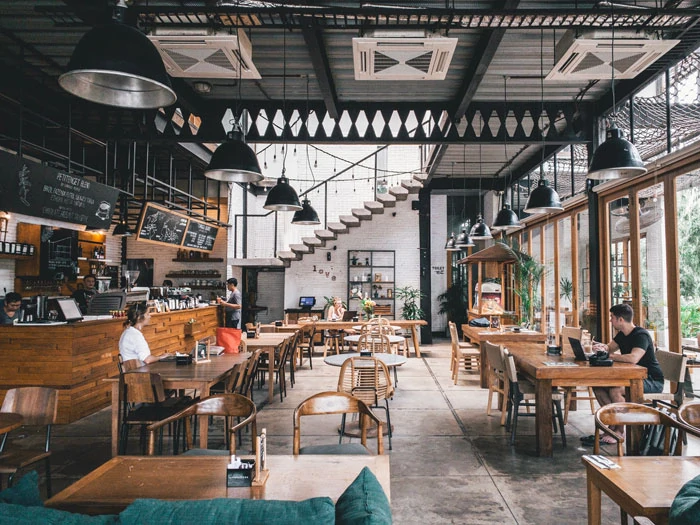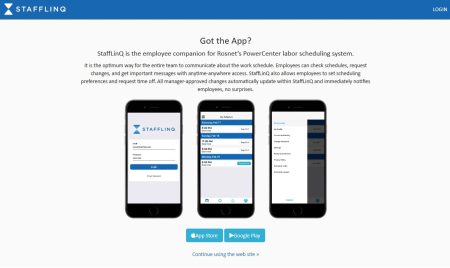Most of restaurant marketing comes down to building strong relationships with customers online and offline. The 13 steps below walk you through the process. With all of the tools available to communicate with your customers and community, marketing your restaurant can quickly become one of your favorite regular tasks as a restaurant owner.
Whether you find the business of opening a restaurant tedious or energizing, you can make sure you haven’t missed a trick by checking out our free Starting a Restaurant e-book. It walks you through the creative choices like deciding the perfect restaurant name alongside tricky things like getting a liquor license.
Now, let’s get to the good stuff; finding the people who will love your restaurant and telling them how awesome it is.
1. Get Your Restaurant Branding
Before you start wall-papering social media with your restaurant logo, you need a killer logo design. If you are a graphic design master, you might be able to design a logo yourself. Most restaurant owners. however, will need to hire a graphic designer. You don’t need to break the bank to do this. Freelance designers are easy to find on sites like Fiverr and 99 Designs. You can get a simple logo design for $50 to $150.
For $250 to $1,000, you can have a designer create a full brand identity for you. This will include everything from your logo to color scheme, fonts for your website and menus, and even to-go container stickers. When you’ve just spent months making a million decisions about menu items and lease contracts, it can be a relief to turn over some decisions to a professional.
2. Design a Restaurant Website
Some 70% of diners check a restaurant’s website before they set foot in the space. Around 62% of diners say that the quality of a restaurant’s website influenced their decision to order takeout or delivery from the business. In the age of online ordering, a website is quickly becoming a necessary part of any restaurant, even small ones.
Many restaurant websites are single, simple pages that include basic information, like:
- Hours of Operation
- Contact information like email address and phone number
- Street Address
- Menus
- Links to online ordering, reservations, or waitlist pages
Some restaurants hire graphic designers to build a custom website from scratch. If you are comfortable with basic drag-and-drop design functions, however, you can build your own website in a few hours on a platform like Squarespace or WordPress. While you’re in the website development phase, you’ll want to buy a custom domain so that customers can easily find your site with your restaurant name.
Squarespace rolls the cost of the domain and hosting into their monthly subscription fees, usually $12 to $15 per month. If you choose WordPress to build your website, you’ll need to get a domain from a platform like Bluehost. For $2,99 to $5.99 per month, Bluehost can also create customized email addresses for you and your managers so customers can reach you at a professional email address rather than a personal email account.
Whichever route you choose to build your restaurant website, you want to ensure that it is:
- Quick loading
- Easy to navigate
- Visually pleasing
Many restaurants achieve this with a simple design that makes it easy for customers to find whatever information they need. You can achieve this design by hiring a web designer. Or, if you are more a do-it-yourselfer, check out our step-by-step guide to building a restaurant website. You might also want to try the Divi WordPress theme. It’s an incredibly popular theme for restaurants because it allows you to edit your page with drag-and-drop design elements.
3. Claim Restaurant Pages on Internet Platforms
While you are on the internet, take the time to navigate to Yelp, TripAdvisor, and Google and claim your business listings. This is an important step. Once your business is up and running, these third-party sites will generate a profile for your business based on customer reviews. If you don’t claim these listings as your business, it is possible that another interested party will be able to update the information in them without your knowledge or consent.
Recently some restaurants’ Yelp and Google listings were updated by a third-party delivery platform who routed delivery orders for those restaurants to their own platform. This robbed the restaurant of the ability to provide their brand of customer service, or even ensure that the dishes the customer wanted were available. Claiming your listings in the beginning will prevent nightmare scenarios. It is easy to do, and will only take you a few hours to register everywhere.
Setting up a Google My Business (GMB) listing is an absolute necessity. GMB is a free online business listing platform. Local businesses add contact, product, and service information, then these GMB listings appear in Google search results and on Google Maps when people search for a business. To get started visit Google My Business and create a business profile. Google will send you an email to verify your account and connect it to your business email (that you set up in the previous step, right?).
Yelp and TripAdvisor follow a similar process. Once you have these listings set up, you’ll want to claim your restaurant’s social media handle on all the major social media platforms. Even if you don’t plan to use TikTok to market your restaurant right away, creating a profile with your restaurant’s name prevents an impersonator from creating one that could confuse your customers. One day you may discover that your line cook is a TikTok wizard and would love to add content to that account for you, and you’ll be glad you already created it.
When claiming listings and business profiles, check all of these sites and platforms:
- Google My Business
- Yelp
- TripAdvisor
- TikTok
- YouTube
- Snapchat
You’re not necessarily going to use all of these platforms right away. Some of them you might never use at all. Like scooping a fingerful of icing off a cupcake, you could be claiming it for later, or simply making it unappealing for someone else to claim.
4. Plan Your Restaurant’s Social Media Marketing
Your newly minted restaurant social media accounts provide an excellent foundation for building camaraderie with your customers online. In 2019, 89% of diners used social media. Around 42% of those diners interacted directly with restaurants on at least one social media platform. Social media as a marketing platform has grown immensely since 2014 and is projected to continue to grow through 2023.
Social media marketing is a manageable, low cost way to get your restaurant in front of potential customers. Business owners who use social media to promote their brands have reported that the social media strategies have improved their exposure, sales, and generated loyal customers. These effects make social media marketing an ideal strategy for restaurants.
The most important qualities in restaurant social media management is that your posts and ads are consistent and authentic. Your posts and ads should feature your restaurant’s unique qualities. These might be your food, your ambiance, your team, your service philosophy, the way you support your community, or amazing seasonal celebrations that you host.
You can save time and administrative bandwidth by relying heavily on one platform like Facebook or Instagram. You can use post scheduling apps like Hootsuite. Alternatively, you can hire a social media agency to manage your social media posting and advertising across one or more platforms. Some social media agencies like Hibu, also offer website design packages.
5. Make Your Floor Plan Sociable
When planning your restaurant space, find ways to work in photo-friendly spots in the design. The front entrance where customers either wait in line to order or wait for a table is an ideal spot for a photo-friendly addition. This could be a wall mural of your logo. In a farm-to-table restaurant, it might be a living wall of plants. A vintage themed burger joint might fill a wall with bottles of the 100’s of sodas they serve, like Pop’s 66 Soda Ranch in Arcadia, Oklahoma.
Even high end restaurants can create social media moments for their guests. Guests of Vespertine in Los Angeles are as likely to share a photo of the distinctive building and living flower arrangements as they are the restaurant’s iconic dishes.
6. Make Your Menu Shareable
This step has a few dimensions. First, you’ll want to consider how you showcase your food on plates. A plating that is photo friendly will pop in social posts and generate lots of free buzz for your restaurant when customers share photos of their experiences.
If it fits your restaurant’s style, dropping a tongue-in-cheek menu joke can be a big hit. In 2019, Little Rock restaurant Mama D’s menu went viral because of its cheeky side order titled “My Girlfriend is Not Hungry.” The menu item, priced at $4.25 adds the diner’s choice of extra fries, chicken wings, or cheese sticks to an entree.
Speaking of menu design, you want to design a menu that is easily read online, either on your restaurant website, or for online ordering. The more easily customers can access and navigate your menu, the more likely they are to order from it, and possibly share it with friends.
You can’t talk about menu share-ability without discussing the photo factor. Photographs make a menu pop, especially online. The more crave-able your food looks, the more shareable it becomes. You can easily hire a professional food photographer from a freelancing site like Fiverr. If you are in the mood to do-it-yourself, you can follow the tips in our guide to taking better product photos.
7. Train Staff to Be Authentic Brand Ambassadors
According to a study by American Express, 68% of customers say that interacting with a pleasant staff member is key to their positive service experiences. Some 62% elaborated further, saying that the staff member’s knowledge or resourcefulness was the reason for their positive experience. Pleasant attitudes generally come from good hiring practices and a positive work environment. Knowledge and resourcefulness, however, are all in the training.
Investing in training and a positive work environment can actually boost your bottom line. That same American Express study found that customers are willing to spend 17% more in businesses that provide excellent service.
When hiring, look for qualities that you cannot easily train for, like:
- Optimism: You’re looking for someone who believes that when things go wrong, they can be fixed.
- Empathy: The ability to put oneself in a customer’s shoes never hurts.
- Kindness: When things go wrong, kindness is the first step to smoothing ruffled feathers.
- Willingness to learn from mistakes: Mistakes happen in every restaurant. They are your greatest opportunities to educate yourself and your staff.
With a foundation of kindness, optimism, and empathy, you can train servers how to carry plates or teach cashiers how to run the POS. When training your restaurant team, focus on:
- Knowledge: Knowing the menu inside and out may seem like a big request of your waitstaff, but it is truly one of the things that customers most appreciate.
- Empathetic responses: Literally role play as customers who have had a negative experience. This way empathetic responses like “I understand your frustration,” and “I can fix that for you” will be reflexive.
- Memorable Service: Starbucks built its customer service brand around the idea of legendary service. The formula for legendary service boils down to incredibly reachable goals; knowing your customers and finding a way to make interactions memorable.
Memorable, or legendary service doesn’t have to cost a lot of money. Sometimes it is as simple as knowing it is a customer’s birthday and writing a “Happy Birthday” message at the top of their menu. Coach your staff to pay attention to the smallest details of a customer interaction, and give them the tools to create memorable moments for your guests.
8. Support Community Events
Restaurants can support community events in multiple ways. You can donate food to a fundraiser, donate gift cards to a raffle, or you and your staff can donate your time to a cause you believe in. Local restaurants sponsoring children’s sports teams is also a time honored tradition. I distinctly remember proudly wearing my “Lou’s Deli Demons” T-shirt for the one season I played T-ball. I also remember enjoying many postgame grape sodas and hoagies at Lou’s.
If you are still waiting to pass fire inspection for your new restaurant, this step can sound premature. You might be thinking, my restaurant isn’t open yet, how can I support community events? Most major community happenings spend the whole year planning their events and fundraisers.
Identifying your business as a source of support early can be a first step to establishing community roots that will help build local excitement about your restaurant. Feeling like you are already part of a community can also give you the boost you need to make it through the homestretch of getting your restaurant open.
9. Join Your local Business Improvement District (or Chamber of Commerce)
Every state—and many cities— has a Chamber of Commerce. These are civic groups made up of local business owners that advocate on behalf of the business community. The process for joining varies slightly from place to place. It is best to contact your local chamber to inquire about membership dues, application process, networking opportunities, benefits, and a membership list.
If your restaurant is located in a busy tourist district or a densely populated city center, you may find that joining a Business Improvement District (BID) is more useful. BIDs are groups of private property owners and businesses that operate within a legally constituted city district. Members pay fees to join, and these fees cover the expense of services that their BID offers.
For example, BIDs in tourist areas may use fees to install street lights and flower boxes throughout the neighborhood. In districts with lots of foot traffic, the local BID may design and post maps for pedestrians. Joining a BID is a fast way to meet other business owners in your neighborhood, many of whom will not be restaurant owners, and could easily become regular customers.
You’re probably seeing a pattern here. The idea with this step (and the ones that precede and follow it) is to build firm ties with an offline community. More than any other business type, restaurants have the ability to become hubs for their community. People often say that restaurants with longevity are a “local institution.” Rooting your restaurant in your community will give it staying power.
Relationships are built over time. If you build your community ties alongside with the construction of your restaurant, you will have a firm network of supporters to rely on during the early days of your business.
10. Join Business Affinity Groups
There are a number of groups in the nation and at local levels dedicated to supporting small businesses that are owned and operated by minority groups, women, veterans, and others. If you are a restaurant owner who qualifies for any of these groups, you should consider joining one. They may offer advice on applying for business loans or grants that are available to your group, as well as organize collective marketing efforts to support all the member businesses.
11. Turn Customer-Generated Content Into Social Media Posts
Once you’ve followed all the previous steps, you should have an excited group of fans offline, and a strong brand identity across several social media platforms. Now is the time to combine those two resources and turn love for your restaurant into sales.
Before opening to the public, most restaurants host a soft-opening. This is usually a mock-service where you invite friends and family to visit the restaurant before it opens. It gives your staff a chance to practice cooking and serving your food and drinks to guests before they are paying customers.
This is a great opportunity to get lots of raw material for future social media posts, retweets, re-grams, and social media advertising for your restaurant. Encourage attendees to take pictures of your restaurant space, food, and beverages. Ask them to tag your restaurant on any social media platforms where they post these images. This is also a good time to bring in a professional food photographer to capture images for you to use later.
Over the days and weeks after your soft opening you can share your customer generated images and comments on your restaurant’s social media channels. Be sure to thank these customers for their comments and pictures in your posts, and attribute who took the picture.
12. Send a Press Release to Local News Outlets
The term press release can sound intimidating. A press release is just a simple document that offers media outlets newsworthy business information. A new restaurant opening might not be national news, but it is definitely newsworthy to local newspapers, blogs, and food websites. You want your press release to be short and sweet. It should include your restaurant’s location and contact information.
If your restaurant has a compelling story, include that as well. If you have recently immigrated to the area and are serving traditional food, that is a great angle for local news outlets. A restaurant that makes use of unusual spaces like a historic home, old mill, or repurposed Airstream trailer is another. If you are reopening a beloved local favorite spot after a fire or after a previous owner retired, the community would love to hear about it.
13. Announce Your Opening Across All Your New Channels
By now you have great photos of your food. You have made friends online and off. You have a detailed press release with all the relevant information about your restaurant. Before you officially open your doors, tell all your contacts when they can officially start celebrating their birthday dinners and date nights at your restaurant.
- Call or text: Nearby business owners, business mentors who have advised you through the process and anyone who is close to the restaurant should get a personal message from you announcing your opening. Farmers, in particular, love to hear that their produce is about to meet a new audience.
- Send direct messages: Your most active social media followers would love a direct message letting them know how excited you are to see them in person.
- Email: Send an email announcement to every contact, from the construction crews who plastered your bathrooms to the sales rep who helped you set up your POS.
- Post to social media: Post, post, post! Fill your social media channels with photos of your space and your food. Look for volunteers from your staff to create authentic posts.
Bottom Line
Promoting a new restaurant can seem like a daunting task. You need to build strong communities online and offline, and communicate with them regularly in an authentic way that is meaningful to them. Breaking these big goals into smaller steps makes marketing a restaurant manageable. Knowing your limitations and hiring professionals to help with the design work when necessary can also relieve creative pressure and allow you to focus on growing your business.








